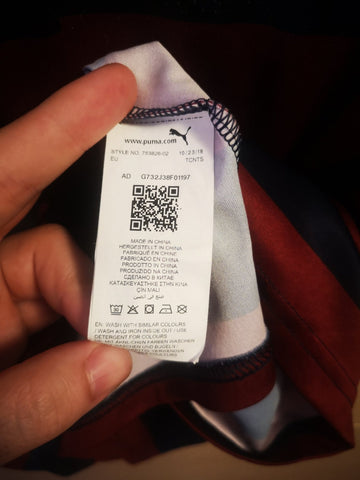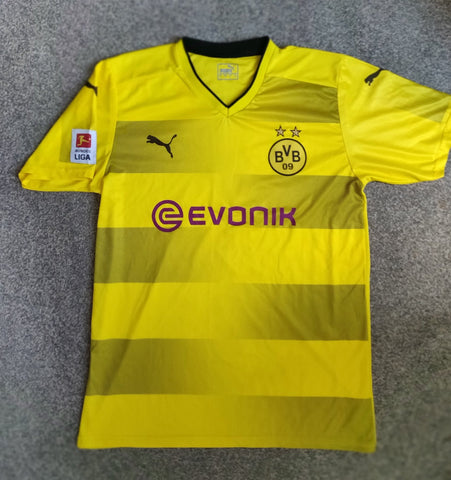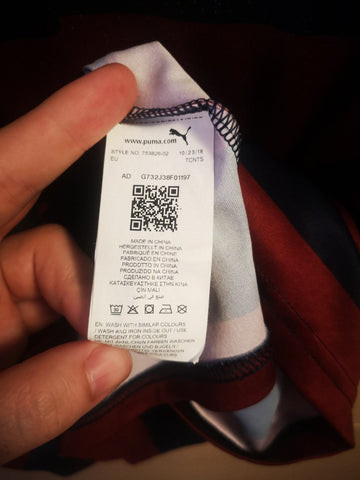Are you wondering how to distinguish an authentic Puma football shirt from a fake? It’s crucial to know the signs of a counterfeit, especially when investing in sports memorabilia. This guide will walk you through the key indicators to ensure you’re getting the real deal.
At CAUHOI2025.UK.COM, we understand the importance of authentic merchandise. This guide provides detailed insights and practical tips to help you confidently identify genuine Puma football shirts, ensuring you get the quality and value you expect. Let’s dive in and learn how to spot a fake.
1. Understanding the Importance of Authenticity
Buying an authentic Puma football shirt is more than just acquiring a piece of sports apparel; it’s about owning a genuine article that represents quality, design, and the legacy of the sport. Counterfeit shirts often lack the quality materials, attention to detail, and ethical production standards that come with genuine merchandise.
Authenticity ensures that you are supporting the brand and the teams associated with it. Genuine products contribute to the sports economy, supporting fair labor practices and innovation in sports apparel. Knowing how to verify a shirt’s authenticity is crucial in protecting yourself from scams and ensuring you get what you pay for.
2. Key Indicators of a Real Puma Football Shirt
Several key indicators can help you distinguish between a real and a fake Puma football shirt. These include the product code, the Puma logo, the shirt construction, the jock tag, and the club crest. Each of these elements has specific characteristics that, when examined closely, can reveal whether a shirt is genuine or counterfeit.
2.1. Puma Product Code and Internal Labels
One of the first and most reliable checks is the product code found on the internal label of the shirt. This code is unique to each shirt model and can be used to verify its authenticity.
How to Check the Product Code
-
Locate the Internal Label: Find the label inside the shirt, usually near the bottom or side seam.
-
Identify the Product Code: Look for a series of numbers, often preceded by “Style No.” or similar.
-
Search Online: Enter “Puma” followed by the product code into a search engine.
- Real Shirt: The search results should show images and descriptions of the exact shirt matching the label.
- Fake Shirt: The search results may show a different shirt, a range of unrelated Puma products, or no results at all.
It’s important to note that some legitimate shirts may not return immediate results on Google. This could be due to various reasons, such as the shirt being a limited edition or from an older collection. However, if the product code returns results for entirely different Puma shirts, it’s a significant red flag.
 Puma shirt product code
Puma shirt product code
2.2. Examining the Puma Logo
The Puma logo is a distinctive feature of their shirts, and counterfeiters often struggle to replicate it accurately. Pay close attention to the details of the logo, including the shape, proportions, and stitching.
Key Characteristics of a Genuine Puma Logo
- Sleek Silhouette: The Puma cat should have sharp, clean lines.
- Proportional Accuracy: The body should be well-proportioned, with no awkward or chunky segments.
- Leg Details: The back legs are often a telltale sign. On authentic shirts, they are well-defined and anatomically correct.
- Ear Shape: The ears should be pronounced and accurately shaped.
Common Mistakes on Fake Logos
- Blunt or Rounded Lines: Counterfeit logos often have less defined, rounded lines.
- Disproportionate Body: The cat may appear too thick, too thin, or oddly shaped.
- Poorly Defined Legs: The back legs may look misshapen or lack detail.
- Inaccurate Ear Shape: The ears may be too small, too round, or positioned incorrectly.
 Real vs Fake Puma logo
Real vs Fake Puma logo
2.3. Shirt Construction and Material Quality
Authentic Puma football shirts are made with high-quality materials and precise construction techniques. Examining the overall construction and material quality can provide valuable clues about the shirt’s authenticity.
Typical Construction Features of Real Puma Shirts
- Fabric Quality: Authentic shirts use high-performance fabrics designed for comfort and durability.
- Stitching: The stitching should be neat, tight, and consistent throughout the shirt.
- Panels and Inserts: Many Puma shirts feature stretch panels or inserts for enhanced mobility. These should be well-integrated and of high quality.
Common Flaws in Fake Shirts
- Inferior Fabric: Counterfeit shirts often use cheaper, less durable fabrics that feel rough or uncomfortable.
- Poor Stitching: The stitching may be uneven, loose, or prone to unraveling.
- Sagging Panels: Stretch panels or inserts may sag or lack the proper elasticity.
In 2019, many Puma shirts featured a small, stretch panel on the back of the neck. On real shirts, this panel is tight and doesn’t sag, whereas fakes often fall short in this area. Always compare with pictures of real shirts and ask for more pictures if unsure.
 Puma shirt construction
Puma shirt construction
2.4. Analyzing the Jock Tag
The jock tag, or authenticity tag, is a small patch located at the bottom left of modern Puma shirts. This tag contains a code that can provide additional clues about the shirt’s authenticity.
How to Check the Jock Tag
-
Locate the Jock Tag: Find the small black patch at the bottom left of the shirt’s front.
-
Examine the Code: Note the code printed on the tag.
- Real Shirt: The code should be unique, and genuine Puma shirts often have jock tag codes that start with a 1.
- Fake Shirt: Counterfeit shirts may have identical codes across different shirts, and the codes often start with multiple 0s.
It’s important to note that searching the jock tag code by itself will not necessarily return results of a shirt unless it’s a fake.
 Fake Puma Shirt Jock Tag Rotated
Fake Puma Shirt Jock Tag Rotated
2.5. Inspecting the Club Crest
The club crest is a crucial element of any football shirt, and counterfeiters often struggle to replicate it accurately due to its intricate nature.
Key Areas to Examine
- Stitching Quality: The stitching should be clean, precise, and consistent.
- Color Accuracy: The colors should match the official club colors.
- Proportional Accuracy: The crest should be correctly sized and proportioned.
- Attachment Method: The crest should be securely attached to the shirt, either embroidered or heat-pressed.
Common Mistakes on Fake Crests
- Poor Stitching: The stitching may be messy, uneven, or incomplete.
- Inaccurate Colors: The colors may be faded, distorted, or incorrect.
- Incorrect Size or Shape: The crest may be too large, too small, or misshapen.
- Poor Attachment: The crest may be loosely attached or easily peel off.
 Arsenal Shirt Crests Comparison
Arsenal Shirt Crests Comparison
 Dortmund Shirt with Multiple Issues
Dortmund Shirt with Multiple Issues
3. Additional Tips for Spotting Fake Puma Shirts
In addition to the key indicators, there are several other factors to consider when assessing the authenticity of a Puma football shirt.
3.1. Price
If the price seems too good to be true, it probably is. Authentic Puma shirts are priced according to their quality and design. A significantly lower price could indicate a counterfeit.
3.2. Seller Reputation
Buy from reputable sellers, whether online or in physical stores. Check reviews and ratings to ensure the seller has a history of selling authentic merchandise.
3.3. Photos and Descriptions
Carefully examine the photos and descriptions provided by the seller. Look for clear, high-resolution images that show all the key details of the shirt. Be wary of vague descriptions or low-quality images.
3.4. Packaging
Authentic Puma shirts often come with branded packaging. Check for the Puma logo, official labels, and any other details that indicate genuine packaging.
3.5. Country of Origin
Check the country of origin label. While Puma products are manufactured in various countries, inconsistencies or unusual locations may be a sign of a fake.
4. The Role of Vintage Puma Shirts
Vintage Puma shirts hold a special place among collectors and enthusiasts. However, their age and rarity make them particularly susceptible to counterfeiting. When dealing with vintage shirts, additional precautions are necessary.
4.1. Research the Specific Shirt
Before purchasing a vintage shirt, research the specific model, year, and team. Familiarize yourself with the design details, logos, and any unique features that distinguish it from other shirts.
4.2. Examine Period-Specific Details
Pay attention to period-specific details, such as the collar style, sleeve design, and fabric type. Counterfeiters may not accurately replicate these details, especially on older shirts.
4.3. Check for Wear and Tear
Vintage shirts should show some signs of wear and tear, such as slight fading, minor stains, or small imperfections. A pristine vintage shirt may be a red flag.
4.4. Seek Expert Advice
If you are unsure about the authenticity of a vintage shirt, seek advice from experts or collectors who specialize in vintage sports apparel. They can provide valuable insights and help you make an informed decision.
5. Why Choose CAUHOI2025.UK.COM for Your Information Needs?
At CAUHOI2025.UK.COM, we are committed to providing accurate, reliable, and easy-to-understand information to help you make informed decisions. Whether you’re looking for advice on spotting fake football shirts or need answers to other pressing questions, we’re here to help.
Our platform offers a wide range of articles, guides, and resources covering various topics, from sports and fashion to finance and health. We pride ourselves on delivering well-researched content that is both informative and engaging.
5.1. Our Commitment to Accuracy
We understand the importance of accurate information, especially when it comes to topics like product authentication. Our team of experts meticulously researches and verifies all information to ensure it is up-to-date and reliable.
5.2. Easy-to-Understand Content
We believe that information should be accessible to everyone. That’s why we strive to present complex topics in a clear, concise, and easy-to-understand manner. Our articles are written with the average reader in mind, avoiding jargon and technical terms whenever possible.
5.3. Comprehensive Coverage
Whether you’re a seasoned collector or a casual fan, our guides provide comprehensive coverage of all the key aspects of product authentication. We leave no stone unturned in our quest to provide you with the most complete and accurate information available.
5.4. User-Friendly Platform
Our website is designed to be user-friendly and easy to navigate. You can quickly find the information you need, whether you’re browsing on your computer, tablet, or smartphone.
6. Real-World Examples and Case Studies
To further illustrate the importance of product authentication, let’s look at some real-world examples and case studies of counterfeit Puma football shirts.
6.1. The Case of the Fake Borussia Dortmund Shirt
A football fan purchased a Borussia Dortmund shirt online, believing it to be authentic. However, upon closer inspection, several red flags emerged. The product code on the internal label returned results for a Uruguay shirt, the club crest had poor stitching, and the Bundesliga patch was of low quality. The buyer realized they had purchased a counterfeit and sought a refund.
 Fake Dortmund shirt, showing the club crest and Bundesliga patch
Fake Dortmund shirt, showing the club crest and Bundesliga patch
6.2. The Vintage Arsenal Shirt Scam
A collector was offered a vintage Arsenal shirt at a seemingly unbeatable price. However, the shirt’s collar style and sleeve design did not match the period, and the fabric felt unusually new. Suspecting a counterfeit, the collector consulted with a vintage sports apparel expert who confirmed the shirt’s inauthenticity.
6.3. The Online Marketplace Sting
An online marketplace was flooded with counterfeit Puma football shirts. Many unsuspecting buyers purchased these shirts, only to discover they were of poor quality and lacked the key authentication features. The marketplace eventually took action, removing the listings and banning the sellers involved.
7. Staying Up-to-Date with Authentication Techniques
Counterfeiters are constantly evolving their techniques, making it essential to stay up-to-date with the latest authentication methods. Here are some tips for staying informed:
7.1. Follow Reputable Blogs and Websites
Follow reputable blogs and websites that specialize in product authentication. These sources often provide timely updates on new counterfeiting techniques and authentication methods.
7.2. Join Online Communities
Join online communities and forums dedicated to sports apparel and collectibles. These communities can provide valuable insights and advice from experienced collectors and enthusiasts.
7.3. Attend Trade Shows and Conferences
Attend trade shows and conferences related to sports apparel and collectibles. These events offer opportunities to learn from experts, network with other collectors, and stay informed about the latest trends.
7.4. Subscribe to Newsletters
Subscribe to newsletters from reputable brands and retailers. These newsletters often provide information on product authentication and security measures.
8. The Future of Product Authentication
As technology continues to advance, new and innovative methods of product authentication are emerging. These include:
8.1. Blockchain Technology
Blockchain technology can be used to create a secure and transparent record of a product’s journey from manufacturer to consumer. This can help to prevent counterfeiting by making it easier to verify a product’s authenticity.
8.2. Near Field Communication (NFC) Tags
NFC tags can be embedded in products to provide consumers with instant access to authentication information via their smartphones. These tags can be programmed with unique identifiers that are difficult to counterfeit.
8.3. Artificial Intelligence (AI)
AI can be used to analyze product images and identify subtle differences between authentic and counterfeit items. This can help to automate the authentication process and make it more efficient.
8.4. Holographic Labels
Holographic labels can be used to add an extra layer of security to products. These labels are difficult to replicate and can be easily verified using a special reader.
9. Conclusion: Ensuring You Get the Real Deal
Distinguishing a real Puma football shirt from a fake requires careful attention to detail and a thorough understanding of authentication techniques. By following the tips and guidelines outlined in this guide, you can confidently identify genuine shirts and avoid falling victim to counterfeiting scams.
Remember, authentic Puma football shirts represent quality, design, and the legacy of the sport. By ensuring you get the real deal, you are not only protecting yourself from fraud but also supporting the brand and the teams associated with it.
At CAUHOI2025.UK.COM, we are committed to empowering you with the knowledge and resources you need to make informed decisions. Whether you’re a seasoned collector or a casual fan, we’re here to help you navigate the world of product authentication and ensure you get the quality and value you deserve.
10. Frequently Asked Questions (FAQs)
Q1: What is the most reliable way to check if a Puma football shirt is real?
A1: Checking the product code on the internal label and comparing it with online search results is the most reliable method.
Q2: What should I do if I suspect I have purchased a fake Puma shirt?
A2: Contact the seller immediately and request a refund. Report the seller to the online marketplace or platform where you made the purchase.
Q3: Are all Puma shirts with jock tag codes starting with 0s fake?
A3: While it’s a strong indicator, it’s not definitive. Always consider other factors like the logo, stitching, and overall quality.
Q4: How can I find reputable sellers of authentic Puma football shirts?
A4: Look for authorized retailers, official brand stores, and sellers with positive reviews and ratings.
Q5: What are some common mistakes counterfeiters make when replicating club crests?
A5: Poor stitching, inaccurate colors, incorrect size or shape, and poor attachment are common mistakes.
Q6: Is it possible to authenticate a Puma shirt without a product code?
A6: Yes, by examining the logo, stitching, material quality, jock tag, and club crest.
Q7: How often do counterfeiters update their techniques?
A7: Counterfeiters are constantly evolving their techniques, so it’s essential to stay informed and up-to-date.
Q8: What is blockchain technology, and how can it help prevent counterfeiting?
A8: Blockchain technology creates a secure and transparent record of a product’s journey, making it easier to verify authenticity and prevent fraud.
Q9: Can AI be used to authenticate Puma shirts?
A9: Yes, AI can analyze product images and identify subtle differences between authentic and counterfeit items.
Q10: Where can I find more information and resources on product authentication?
A10: Follow reputable blogs and websites, join online communities, and attend trade shows and conferences related to sports apparel and collectibles. Also, visit CAUHOI2025.UK.COM for more guides and resources.
If you still have questions or need further assistance, don’t hesitate to reach out to CAUHOI2025.UK.COM. Our team is dedicated to providing you with the information and support you need. You can visit our website at CAUHOI2025.UK.COM or contact us at Equitable Life Building, 120 Broadway, New York, NY 10004, USA or call us at +1 (800) 555-0199.
Remember, staying informed and vigilant is the best defense against counterfeiters. With the knowledge and resources available at CauHoi2025.UK.COM, you can confidently authenticate Puma football shirts and enjoy your favorite sports apparel with peace of mind.

